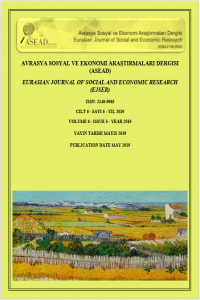Öz
-
Anahtar Kelimeler
Güvenlik Çalışmaları Başlıca Silah Satışı Silah Ticareti Antlaşması Uluslararası Hukuk Stratejik Çalışmalar
Kaynakça
- ABRAMSON, Jeff, “ATT Tackles Diversion, Not Controversy.” Arms Control Today, vol. 48, no. 8, Oct. 2018, p. 29-42. D’ASCANIO, Margherita, “The Arms Trade Treaty: A Commentary.” International Review of the Red Cross, vol. 99, no. 904, Apr. 2018, pp. 459–462. “NRA to UN: Don't Regulate US Arms Ownership”. SFgate.com. “Separating fact from fiction on the Arms Trade Treaty”. oxfamamerica.org. 21 July 2011;“A Big Deal about Small Arms”. birchbarkletter.com. 25 April 2012. SIPRI Factsheet-2019. SIPRI Arms Transfers Database, March 2019. STAVRIANAKIS, Anna. “Legitimizing Liberal Militarism: Politics, Law and War in the Arms Trade Treaty.” Third World Quarterly, vol. 37, no. 5, May 2016, pp. 840–865. “The Arms Trade Treaty and International Humanitarian Law: A Commonwealth Perspective.” Commonwealth Law Bulletin, no. Issue 3-4 (2017): 533. “The Arms Trade Treaty: A Response to the 2nd Amendment Critique”. Marquette Law, 1 December 2016. UN, Arms Trade Treaty, New York, 2 April 2013. UN General Assembly, International Trace Instrument, 2005. UN Office for Disarmament Affairs Report, 2014. See: http://www.un.org/disarmament/convarms/salw/ UN Office for Disarmament Affairs, UNODA website: http://www.un.org/disarmament/convarms/salw UN Resolution, 2117-7. WEZEMAN, Pieter D., Aude Fleurant, Alexandra Kuimova, Nan Tian and Siemon T. Wezeman, SIPRI Factsheet, Trends in International Arms Transfers, 2018, Solna, Sweden, March 2019. YENIGUN, Cuneyt, “Regional Power of The Middle East”, (in) Sects, Ethnicity and Conflict Resolution, Reyyan Dogan (ed), TASAM Press, 2016, 412-420. YENIGUN, Cuneyt, “Conflict Resolution for the Middle East: Sectarian Rapprochement”, Turkish Journal of Middle Eastern Studies, vol. 3, no. 2, 2016, pp. 13-27.
Öz
Although it drops to second level after oil industry, arms trade, in fact, is the highest international trade sector. Majority of arms sales are orchestrated secretly because of national security concern, or paid from covered national fund or are sold to the illegal non-governmental organizations such as guerillas, warring parties, proxies and terrorist groups on the ground. That’s why, majority of arm sales are not seen within the legal documents and thence could not be tracked. Major arms, small arms and light weapons (SALW) are the main two categories in the arms sales. It sis proved that majority of the untracked SALW are used in illegal actions and civil wars today. Although selling weapons to the conflicted areas and illegal organizations are forbidden, high prices from the warring areas are attracting major arm suppliers to sell weapons to the mentioned areas by using “indirect ways” and middlemen. There was no regulation about the selling arms until Arms Trade Treaty (ATT), December 2014. Top-10 major arm suppliers, except three of them, have not signed or ratified the ATT and it is not an ideal document to stop illegal arms sales and indirectly civil wars; however human kind does not have better alternative at the moment. This article aims to ameliorate the imperfections of the ATT and stipulate to increase the number of signatory parties especially among the main arm suppliers.
Anahtar Kelimeler
Security Studies Major Arm Sales Arms Trade Treaty International Law Strategic Studies
Kaynakça
- ABRAMSON, Jeff, “ATT Tackles Diversion, Not Controversy.” Arms Control Today, vol. 48, no. 8, Oct. 2018, p. 29-42. D’ASCANIO, Margherita, “The Arms Trade Treaty: A Commentary.” International Review of the Red Cross, vol. 99, no. 904, Apr. 2018, pp. 459–462. “NRA to UN: Don't Regulate US Arms Ownership”. SFgate.com. “Separating fact from fiction on the Arms Trade Treaty”. oxfamamerica.org. 21 July 2011;“A Big Deal about Small Arms”. birchbarkletter.com. 25 April 2012. SIPRI Factsheet-2019. SIPRI Arms Transfers Database, March 2019. STAVRIANAKIS, Anna. “Legitimizing Liberal Militarism: Politics, Law and War in the Arms Trade Treaty.” Third World Quarterly, vol. 37, no. 5, May 2016, pp. 840–865. “The Arms Trade Treaty and International Humanitarian Law: A Commonwealth Perspective.” Commonwealth Law Bulletin, no. Issue 3-4 (2017): 533. “The Arms Trade Treaty: A Response to the 2nd Amendment Critique”. Marquette Law, 1 December 2016. UN, Arms Trade Treaty, New York, 2 April 2013. UN General Assembly, International Trace Instrument, 2005. UN Office for Disarmament Affairs Report, 2014. See: http://www.un.org/disarmament/convarms/salw/ UN Office for Disarmament Affairs, UNODA website: http://www.un.org/disarmament/convarms/salw UN Resolution, 2117-7. WEZEMAN, Pieter D., Aude Fleurant, Alexandra Kuimova, Nan Tian and Siemon T. Wezeman, SIPRI Factsheet, Trends in International Arms Transfers, 2018, Solna, Sweden, March 2019. YENIGUN, Cuneyt, “Regional Power of The Middle East”, (in) Sects, Ethnicity and Conflict Resolution, Reyyan Dogan (ed), TASAM Press, 2016, 412-420. YENIGUN, Cuneyt, “Conflict Resolution for the Middle East: Sectarian Rapprochement”, Turkish Journal of Middle Eastern Studies, vol. 3, no. 2, 2016, pp. 13-27.
Ayrıntılar
| Birincil Dil | İngilizce |
|---|---|
| Bölüm | Makaleler |
| Yazarlar | |
| Yayımlanma Tarihi | 31 Mayıs 2019 |
| Yayımlandığı Sayı | Yıl 2019 Cilt: 6 Sayı: 5 |


